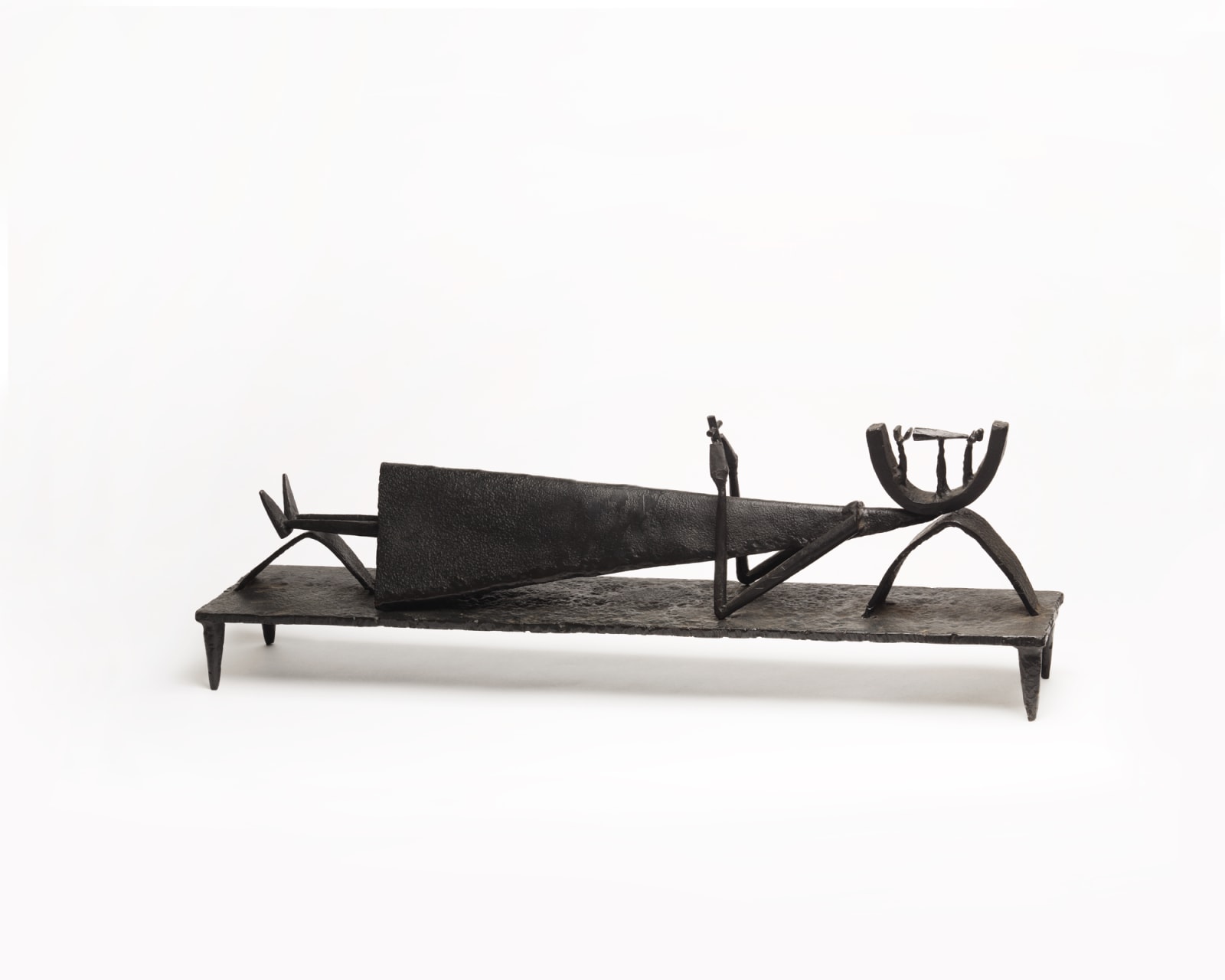Geoffrey Clarke British, 1924-2014
Effigy, 1951
Iron
27 x 81 x 16 cm
10 5/8 x 31 7/8 x 6 1/4 in
10 5/8 x 31 7/8 x 6 1/4 in
Unique
Geoffrey Clarke began his pioneering experiments with forged and welded iron in 1950, at a time when many of his contemporaries continued to employ more traditional materials. Along with Reg...
Geoffrey Clarke began his pioneering experiments with forged and welded iron in 1950, at a time when many of his contemporaries continued to employ more traditional materials. Along with Reg Butler and Lynn Chadwick, Clarke learnt how to weld on a course held at the British Oxygen Company in 1950.
In 1952, the year after Effigy was crated, Clarke was one of the emerging sculptors selected to represent Great Britain at the Venice Biennale. Alongside his contemporaries Reg Butler and Lynn Chadwick, Clarke’s work was described in 1952 by the influential art critic Herbert Read as evoking the ‘geometry of fear’. In this way, Clarke’s early works such as ‘Effigy’, were to be characterised by their battered or tortured appearance. With its innovative use of iron as a material, works like ‘Effigy’ radically reframed what figurative sculpture could be in what Read termed ‘Britain’s New Iron Age’ (1953).
In the early to mid-1950s Clarke used iron, stained glass, enamel and printmaking techniques to create linear images of Man. Clarke then began making a number of important discoveries casting in aluminium. In the 1950s he successfully experimented with making models of his sculptures in the then-relatively new material of polystyrene, and direct casting in aluminium. This process was relatively inexpensive in comparison to casting in bronze, and produced sculptures of lighter weight. Public commissions came thick and fast. Clarke’s dual success in both stained glass and sculpture was marked by a series of significant exhibitions and commissions in the 1950s and 60s.
Examples of Clarke’s sculpture can be seen in many prestigious public and private collections including the Tate, The British Museum, The Henry Moore Institute and The Ingram Collection. The Victoria and Albert Museum has recently acquired a new Aumbry panel by Clarke for their collection and in recent years Clarke has been the object of increasing public and academic interest.
In November 2017 a retrospective of Clarke’s work was held at Pangolin London to coincide with the publication of the artist’s complete catalogue raisonné researched and written by Dr Judith LeGrove and published by Pangolin Press & Lund Humphries. Pangolin London is delighted to represent the estate of Geoffrey Clarke. For more information please contact the gallery.
In 1952, the year after Effigy was crated, Clarke was one of the emerging sculptors selected to represent Great Britain at the Venice Biennale. Alongside his contemporaries Reg Butler and Lynn Chadwick, Clarke’s work was described in 1952 by the influential art critic Herbert Read as evoking the ‘geometry of fear’. In this way, Clarke’s early works such as ‘Effigy’, were to be characterised by their battered or tortured appearance. With its innovative use of iron as a material, works like ‘Effigy’ radically reframed what figurative sculpture could be in what Read termed ‘Britain’s New Iron Age’ (1953).
In the early to mid-1950s Clarke used iron, stained glass, enamel and printmaking techniques to create linear images of Man. Clarke then began making a number of important discoveries casting in aluminium. In the 1950s he successfully experimented with making models of his sculptures in the then-relatively new material of polystyrene, and direct casting in aluminium. This process was relatively inexpensive in comparison to casting in bronze, and produced sculptures of lighter weight. Public commissions came thick and fast. Clarke’s dual success in both stained glass and sculpture was marked by a series of significant exhibitions and commissions in the 1950s and 60s.
Examples of Clarke’s sculpture can be seen in many prestigious public and private collections including the Tate, The British Museum, The Henry Moore Institute and The Ingram Collection. The Victoria and Albert Museum has recently acquired a new Aumbry panel by Clarke for their collection and in recent years Clarke has been the object of increasing public and academic interest.
In November 2017 a retrospective of Clarke’s work was held at Pangolin London to coincide with the publication of the artist’s complete catalogue raisonné researched and written by Dr Judith LeGrove and published by Pangolin Press & Lund Humphries. Pangolin London is delighted to represent the estate of Geoffrey Clarke. For more information please contact the gallery.
Provenance
From the artist's estate
Exhibitions
Masterpiece 2018, PL; Geoffrey Clarke: A Retrospective, 2017; Masterpiece London, 2014; Sculpture in the Home, 2014; FAS, 2000; Ralph Brown and the Figure in the 50s and 60s, 2016, PL.Towards a New World: Sculpture in Post-War Britain, Marlborough Gallery, London March 16 - April 22, 2023
Literature
Geoffrey Clarke Sculptor: Catalogue Raisonne By Dr Judith Le Grove, 2017, pg.26
Publications
Geoffrey Clarke Sculptor: Catalogue Raisonne By Dr Judith Le Grove, 2017, pg.26
Join our mailing list
* denotes required fields
We will process the personal data you have supplied in accordance with our privacy policy (available on request). You can unsubscribe or change your preferences at any time by clicking the link in our emails.
